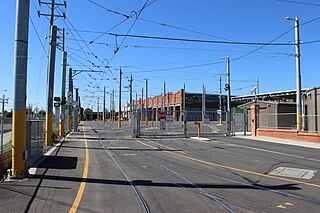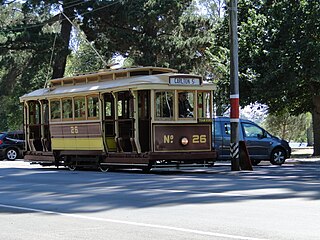
Melbourne tram route 75 is operated by Yarra Trams on the Melbourne tram network from Vermont South to Central Pier. The 22.8 kilometre route is operated out of Camberwell depot with A and B class trams. It is the longest route on the network.

The Melbourne & Metropolitan Tramways Board (MMTB) was a government-owned authority that was responsible for the tram network in Melbourne, Australia between 1919 and 1983, when it was merged into the Metropolitan Transit Authority. It had been formed by the merger of a number of smaller tramway trusts and companies that operated throughout the city.

The Z-class are single-unit bogie trams that operate on the Melbourne tram network. Between 1975 and 1983, 230 trams spanning three sub-classes were built by Comeng, Dandenong. The design was based on two similar Gothenburg tram models, and a prototype built by the Melbourne & Metropolitan Tramways Board. While the Z1 and Z2-class trams were very similar, the Z3-class had significant design changes.

The W-class trams are a family of electric trams built by the Melbourne & Metropolitan Tramways Board (MMTB) between 1923 and 1956. Over the 33 years of production, 752 vehicles spanning 12 sub-classes were constructed, the majority at the MMTB's Preston Workshops.

Hawthorn tram depot was built in April 1916 by the Hawthorn Tramways Trust (HTT). It was built on the corner of Power Street and Wallen Road, Hawthorn, a suburb of Melbourne, Australia. It is also known as the Melbourne Tram Museum. The depot was close to the junction of the HTT's two main lines. It was taken over by the Melbourne & Metropolitan Tramways Board (MMTB) in 1920. In 1925, the depot was used as a school to teach tram drivers and tram conductors. In 1940, the building was also used to make uniforms for MMTB staff.

Preston Workshops is the heavy maintenance facility for the Melbourne tram network. The workshop is located on a block surrounded by Miller Street, St George's Road, Oakover Road and the Mernda railway line in Preston, a suburb of Melbourne, Australia. Following a major redevelopment in April 2016, it also became an operational depot under the name New Preston Depot, taking over from East Preston.
Francis Richard Kirby (1911–1982) was an Australian electrical engineer and tramway administrator. After working at the State Electricity Commission of Victoria as an engineer, Kirby started working for the Melbourne and Metropolitan Tramways Board (MMTB). He became the MMTB's fourth Chairman in 1970, taking over from Robert Risson, and was succeeded by Dudley Snell, the last Chairman of the MMTB, in 1976.
Frederick Dudley Snell was an Australian electrical engineer and tramways administrator. He grew up in Bendigo and following his education worked for the State Electricity Commission of Victoria. After serving in the Royal Australian Air Force during World War II, he commenced work at the Melbourne & Metropolitan Tramways Board (MMTB) in 1953, being appointed the MMTB's fifth and last Chairman in 1976. Following the dissolving of the MMTB into the Metropolitan Transit Authority (MTA) in 1983, he became General Manager of the MTA Bus and Tram Division. Snell worked for the MMTB, MTA, and Leighton Asia on Hong Kong's Tuen Mun light rail system, and died in Hong Kong in 1988.

North Fitzroy tram depot was a depot on the Melbourne tram network. Located on Nicholson Street, North Fitzroy, it opened in 1956 when the Melbourne & Metropolitan Tramways Board converted part of its North Fitzroy bus depot for tramway operation when the Bourke Street to Brunswick East line reopened. In 1976 it became a sub-unit of East Preston depot. It was the smallest tram depot in Melbourne.

The C-class was a group of 11 trams built by Duncan & Fraser, Adelaide for the Prahran & Malvern Tramways Trust (P&MTT) in 1913, numbered 25 to 35. All retained their fleet numbers when passed to the Melbourne & Metropolitan Tramways Board (M&MTB) on 2 February 1920, after it took over the P&MTT. They were designated C-class sometime after October 1921, and by late 1923, all M&MTB drop-end-and-centre Maximum Traction trams were grouped together as C-class trams. The 22E Maximum Traction trucks were of JG Brill design, although manufactured by Brush in England.
The L-class was a class of six trams ordered from James Moore & Sons by the Prahran & Malvern Tramways Trust (PMTT). However, by the time they were delivered in 1921, the PMTT had been taken over by the Melbourne & Metropolitan Tramways Board (MMTB).

The M-class was a class of 17 trams built by Duncan & Fraser, Adelaide for the Hawthorn Tramways Trust (HTT) as numbers 1 to 10, and 33 to 39. All passed to the Melbourne & Metropolitan Tramways Board on 2 February 1920 when it took over the Municipal Tramway Trusts, becoming the M-class and being renumbered 107 to 116, and 183 to 189.
The O-class Melbourne tram were a group of four trams built in 1912 by Duncan & Fraser (Adelaide) for the Prahran & Malvern Tramways Trust (P&MTT) upon the recommendation of W. G. T. Goodman, Chief Engineer and General manager of the Adelaide tramways. They were allocated P&MTT fleet numbers 21 to 24. At the time of their introduction, they were by far the largest street-vehicles in Melbourne, and earned the nicknames Zeppelins and Dreadnoughts. Proving to be less than satisfactory in service, they were later sold to the Hawthorn Tramways Trust (HTT) in August 1916 as "surplus to requirements", however P&MTT soon ordered replacement tramcars. Coincidentally they retained their fleet numbers whilst at Hawthorn.

The P-class was a class of eight trams built by Duncan & Fraser, Adelaide for the Hawthorn Tramway Trust (HTT) as numbers 25 to 32. All passed to the Melbourne & Metropolitan Tramways Board on 2 February 1920 when it took over the HTT becoming the P-class and being renumbered 131 to 138.
The X-class was a class of two Birney trams imported from United States manufacturers JG Brill Company and St Louis Car Company by the Melbourne & Metropolitan Tramways Board. In June 1924 both entered service from Hawthorn depot on the Power Street to Hawthorn Bridge service. In 1928 both were transferred to Glenhuntly depot to operate the Point Ormond route.
The X1-class was a class of ten trams built by the Melbourne & Metropolitan Tramways Board. Developed from the X-class, they differed in having four doors. They were initially allocated to Glenhuntly and Hawthorn depots. Six were transferred to the isolated Footscray network In June 1928 with the other four following in June 1929.
The X2-class was a class of six trams built by the Melbourne & Metropolitan Tramways Board. Developed from the X1-class, they differed in having larger wheels, angled windshields and only two doors.
The Y-class was a one-member tram class built by the Melbourne & Metropolitan Tramways Board. It entered service in September 1927 initially operating a 24-mile tourist service, before being used on regular services on the Burwood line and all night services from Camberwell depot in company with the Y1-class.
The Melbourne tram network began in 1884 with the construction of the Fairfield Horse Tramway. However, the purpose of the line was to increase land prices in the area, and it soon closed during the depression in 1890. The first genuine attempt to construct a tramway network was the construction of the Richmond cable tram line by the Melbourne Tramway & Omnibus Company in 1885. Over the next few years, 16 more cable tram lines were constructed, as well as numerous other horse tramways. The depression of the early 1890s slowed further expansion of the cable network. The first electric tram line was the Box Hill and Doncaster tramway which opened in 1889. This was a pioneering line in what was then the countryside and thus didn't receive much patronage. It closed in 1896. The next attempt at an electric tramway was Victorian Railways' St Kilda to Brighton line, which opened in 1906. Later that year, the North Melbourne Electric Tramway & Lighting Company opened lines to Essendon and Maribyrnong. Many local councils formed their own tramway trusts and built tramways within their own constituency. The most successful of these was the Prahran & Malvern Tramways Trust.
The Melbourne Tramcar Preservation Association is a tram preservation society in Haddon, Victoria, Australia.











